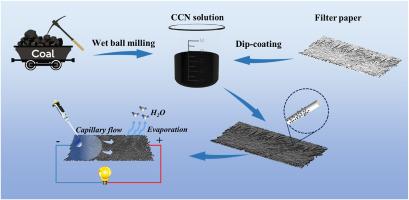导电性煤基纳米碳用于增强发电的水力发电机组
IF 11.6
2区 材料科学
Q1 CHEMISTRY, PHYSICAL
引用次数: 0
摘要
面对不断上升的全球能源需求和环境问题,发展可持续和具有成本效益的能源转换技术势在必行。水力发电通过固液界面相互作用来利用周围的水,为低品位的能量收集提供了一条绿色途径。然而,在这种系统中使用的传统碳基材料通常依赖于石化衍生的前体,限制了可扩展性和环境可持续性。在此,我们报道了一种用低成本和导电的煤基纳米碳(CCN)制造的新型水轮发电机(CCHG)。CCN均匀沉积在滤纸上,形成透水界面,实现水分定向输送和蒸发驱动离子扩散。所制得的CCHG器件在环境条件下输出电压为0.53 V,电流为62 μA,仅需50 μL的水。将多个单元串联或并联集成,可提供高达2.1 V和240 μA的电压,足以驱动LED阵列和定时器等电力商业电子产品。这项工作展示了将煤炭从燃烧燃料转化为增值功能碳材料的可持续战略,为自供电电子和环境传感领域的可扩展、低成本水力发电系统开辟了道路。本文章由计算机程序翻译,如有差异,请以英文原文为准。

Conductive coal-based nanocarbon for hydrovoltaic generator with enhanced electric power generation
The development of sustainable and cost-effective energy conversion technologies is imperative in the face of escalating global energy demands and environmental concerns. Hydrovoltaic power generation, which harnesses ambient water via solid–liquid interface interactions, offers a green pathway for low-grade energy harvesting. However, conventional carbon-based materials used in such systems often rely on petrochemical-derived precursors, limiting the scalability and environmental sustainability. Herein, we report a novel hydrovoltaic generator (CCHG) that fabricated with the low-cost and conductive coal-based nanocarbon (CCN). The CCN is uniformly deposited on the filter paper to form a water-permeable interface, enabling the directional water transport and evaporation-driven ion diffusion. The resultant CCHG device exhibits a voltage output of 0.53 V and a current of 62 μA with only 50 μL of water under ambient conditions. Integration of multiple units in series or parallel delivers up to 2.1 V and 240 μA, sufficient to drive the power commercial electronics such as LED arrays and timers. This work demonstrates a sustainable strategy for transforming coal from a combustion fuel to a value-added functional carbon material, opening the avenues for scalable, low-cost hydrovoltaic power generation systems in self-powered electronics and environmental sensing.
求助全文
通过发布文献求助,成功后即可免费获取论文全文。
去求助
来源期刊

Carbon
工程技术-材料科学:综合
CiteScore
20.80
自引率
7.30%
发文量
0
审稿时长
23 days
期刊介绍:
The journal Carbon is an international multidisciplinary forum for communicating scientific advances in the field of carbon materials. It reports new findings related to the formation, structure, properties, behaviors, and technological applications of carbons. Carbons are a broad class of ordered or disordered solid phases composed primarily of elemental carbon, including but not limited to carbon black, carbon fibers and filaments, carbon nanotubes, diamond and diamond-like carbon, fullerenes, glassy carbon, graphite, graphene, graphene-oxide, porous carbons, pyrolytic carbon, and other sp2 and non-sp2 hybridized carbon systems. Carbon is the companion title to the open access journal Carbon Trends. Relevant application areas for carbon materials include biology and medicine, catalysis, electronic, optoelectronic, spintronic, high-frequency, and photonic devices, energy storage and conversion systems, environmental applications and water treatment, smart materials and systems, and structural and thermal applications.
 求助内容:
求助内容: 应助结果提醒方式:
应助结果提醒方式:


